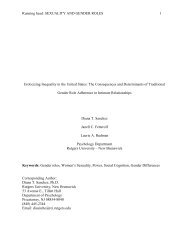Sources of self-categorization as minority for mixed race individuals
Sources of self-categorization as minority for mixed race individuals
Sources of self-categorization as minority for mixed race individuals
Create successful ePaper yourself
Turn your PDF publications into a flip-book with our unique Google optimized e-Paper software.
<strong>Sources</strong> <strong>of</strong> Self-Categorization 15particular, SCT might also predict that after <strong>self</strong>-categorizing <strong>as</strong> <strong>minority</strong>, <strong>individuals</strong> experiencea depersonalization, whereby they view themselves <strong>as</strong> very similar to other members <strong>of</strong> thegroup, and may feel more connected to the group <strong>as</strong> well (Hogg, 2004; Hornsey, 2008; Postmes& Spears, 1998; Tajfel, 1981; Turner, 1991). Thus, <strong>minority</strong> similarity, <strong>minority</strong> appearance, and<strong>minority</strong> connectedness could be viewed <strong>as</strong> products rather than predictors <strong>of</strong> <strong>minority</strong> <strong>self</strong><strong>categorization</strong>.To test this possibility, we computed alternative model A (see Figure 3). Thismodel did not fit the data well (see Table 3). In an additional test <strong>of</strong> SCT, we constructed analternative model very similar to alternative model A, but with <strong>minority</strong> appearance <strong>as</strong> apredictor <strong>of</strong> <strong>minority</strong> and White <strong>self</strong>-<strong>categorization</strong> (alternative model B, see Figure 3). Becausephysical appearance is a relatively stable, observable characteristic, we re<strong>as</strong>oned that it may notbe affected by <strong>minority</strong> <strong>self</strong>-<strong>categorization</strong>, unlike <strong>minority</strong> connectedness, which could varyaccording to <strong>self</strong>-<strong>categorization</strong>. Alternative model B also did not fit the data the data well (seeTable 3). Because the alternative models and the hypothesized model are not nested, a chi squaredifference test cannot be conducted to compare the fit <strong>of</strong> the models. However, in c<strong>as</strong>es <strong>of</strong>nonhierarchical models, fit comparisons can be made using the Akaike In<strong>for</strong>mation Criterion(AIC; Kline, 2005). For a set <strong>of</strong> models, the model with the lowest AIC value h<strong>as</strong> a better fit tothe data. As can be seen in Table 4, the hypothesized model h<strong>as</strong> a lower AIC value (-10.98) thanboth alternative models, suggesting that the hypothesized model is a superior fit to the data.DiscussionIn general, the results supported our hypotheses. Consistent with our predictions, themore <strong>minority</strong>-White biracial participants felt connected to their <strong>minority</strong> group and believedtheir appearance to be similar to other <strong>minority</strong> <strong>individuals</strong>, the more they viewed themselves <strong>as</strong>similar to other members <strong>of</strong> that <strong>minority</strong> group. Additionally, participants who saw themselves



